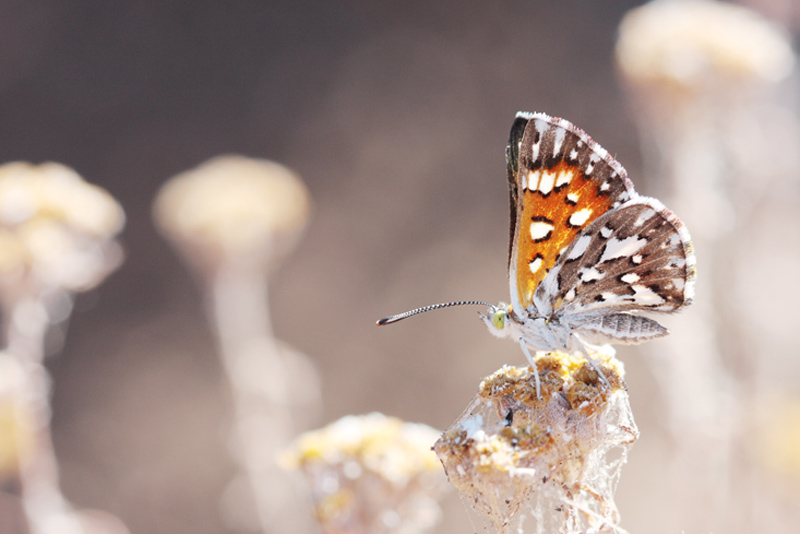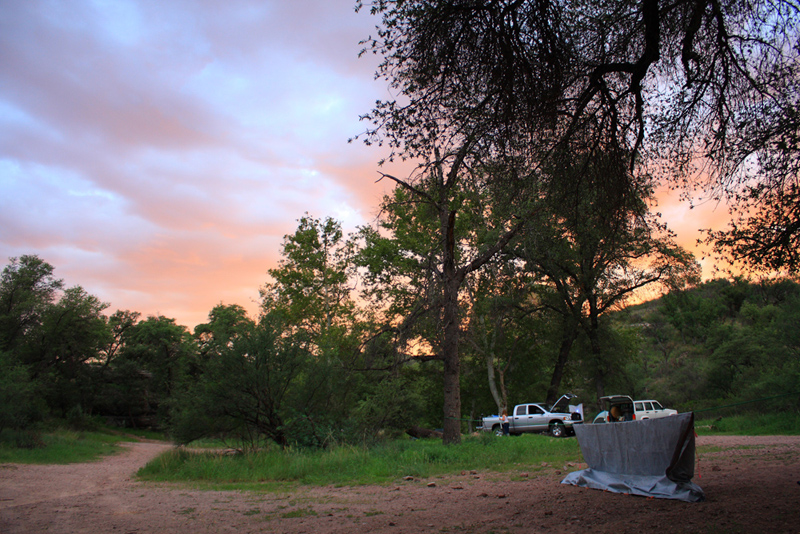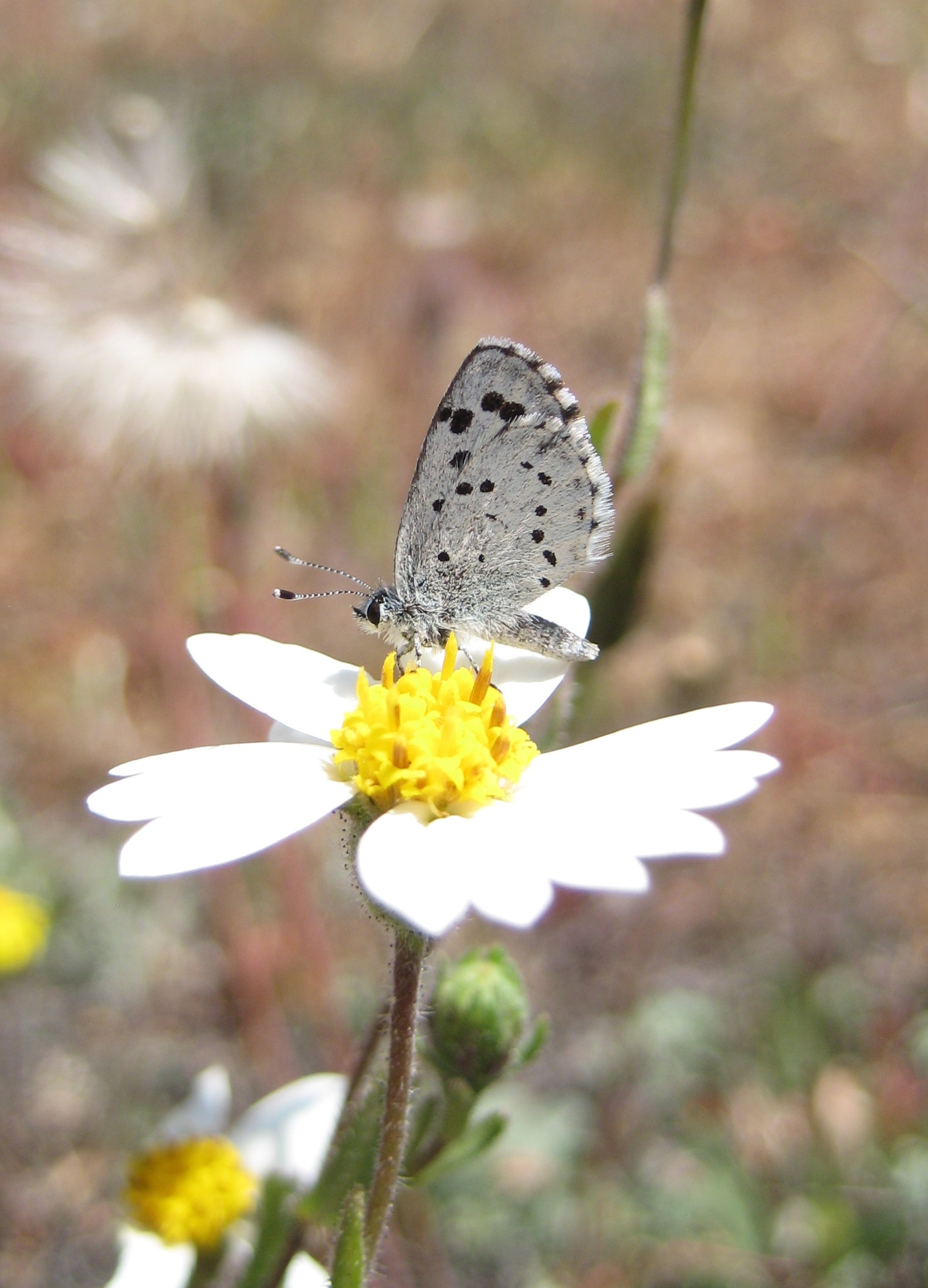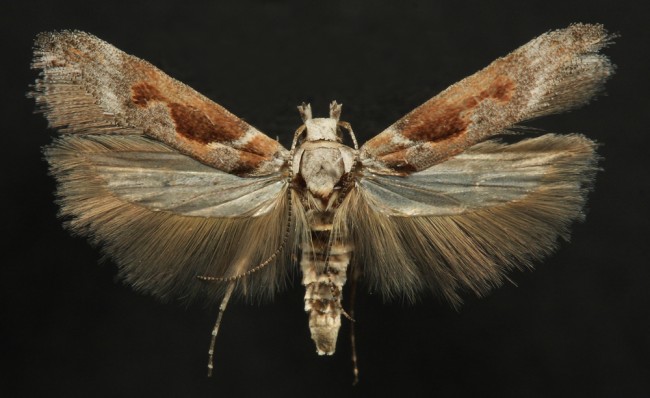Na Chris Grinter, on February 24th, 2010

Know this butterfly? It’s OK, no one really does. It is in the genus Apodemia (Riodinidae), but the taxonomy of this group is a disaster… and don’t even get me started on the subspecies. This specimen was photographed in September, meaning it is most likely to be Apodemia mormo (mormo) based on flight time. A. mormo is a fall flyer and A. virgulti is a spring flyer. While some forms seem distinctive, there is massive morphological overlap and they are usually identical and sympatric – actually down to living on the same plants. But according to lab experiments it is impossible to get the pupae to break diapause so they remain reproductively isolated. So are they different? While molecular work is being conducted the verdict is out, but it does seem like these two species may be retained in the end. Na bila shaka, each mountain range has it’s own subspecies. Who knows, I sure don’t. I’m glad I don’t work on butterflies.
Species concepts are a fuzzy line and it’s never clear exactly where to make the cut. When asked what a species is most people default to the Mayr concept of Biological Species (BSC), where reproductive isolation = new. This is all well and good but we have to keep in mind that this is not the ONLY species concept. Kuna dozens, and not one is perfect. Groups like Grammia (Noctuidae: Artiinae) exhibit high levels of hybridization, which does not adhere well to the BSC. I like to apply as many criteria as possible to delimit a species and it seems like the line is all too commonly thin within insects. I like to see a distinguishing morphological trait, if not in wing color or pattern, at the least in the genitalia or antennae. This is not always the case however and you have to look at the biology and/or DNA. I have looked at two insects that are for all intents and purposes identical. But the biology is radically different and a large % difference (juu ya 8% – ndiyo, arbitrary) in their DNA makes it unquestionable that they are separate.
And if species weren’t contentious enough subspecies stir the pot even more. I’m skeptical about the entire concept, but there are cases in which it seems plausible and necessary. A subspecies is a more formal definition of a geographical “aina” and usually exhibits a blend zone into another subspecies. For instance if you look at the 27 different populations of Plebejus icarioides there are large differences between northern and southern populations, but very subtile difference along the gradient. It is that persistent gradient that creates one dynamic species instead of 27 separate species – at least according to current research. Moths have been lucky and have thus far avoided the plague of over-subspeciation, butterflies not so much. There may even be instances where greedy collectors have named new subspecies of Parnassius for profit (new rare butterfly subspecies sell for big bucks).
The truth is that species concepts are artificial, poorly understood and dynamic at best; at worst it approaches a soft science with no real possibility of proof. Yet species are real and theories will continue to adapt while we sit here and scratch our heads.
Na Chris Grinter, juu ya Februari 23, 2010 

Moja ya manufaa ya kuwa mtaalamu wa wadudu ni kusafiri na kukusanya. Mimi huweka maili elfu chache kwenye gari kila msimu wa joto na hizi ni sehemu mbili bora zaidi za kukusanya huko Arizona. Picha ya juu ni kutoka Milima ya Baboquivari (Kilele cha Baboquivari katikati), Kituo cha Utafiti cha Brown Canyon. The bottom image is of Pena Blanca Canyon, a famous collecting hotspot. This canyon is just 5 miles from Mexico and has a few safety concerns because of our current immigration policy. One morning, while sorting moths from the previous nights catch, a colleague and I had a group of roughly 30 illegals walk right through our camp. They were well dressed and clean, waved, and must have just been dropped off at the fence. Thankfully the majority of illegals are hard-working and honest people trying to earn a better life. It’s the coyotes and smugglers that are scarier – I have heard tales of Mexican police escorting drug caravans into the US with heavy artillery. And just last year a border patrol agent was stabbed to death by a coyote in this vicinity.
Asante, a bunch of strange guys standing around strange lights at nights grants us a wide berth.
(Are these images small enough to load quickly?)
Na Chris Grinter, juu ya Februari 23, 2010 Licha ya kutopendezwa sana na vipepeo, wao ni wazuri kutazama. Hapa kuna video nzuri sana ya mvulana ninayemfahamu huko Kusini mwa CA. Video zake za mzunguko wa maisha wa lepidoptera ni za kuvutia sana, na huyu hasa ni mrembo. Ikiwa unakata karibu 3:00 katika, you will see dozens of Great Purple Hairstreaks (Atlides halesus) emerging from their chrysalises, the colors are stunning. This butterfly is native to the SW and Mexico, and I have to admit I love finding it in the field.
[youtube=http://www.youtube.com/watch?v=KyWJlpIchkE]
Na Chris Grinter, juu ya Februari 23, 2010 The brief comment about Linus Pauling and Vitamin C below made me remember this video first posted a while ago by Pharyngula. Hii ni Kary Mullis, inventor ya PCR, na mshindi wa Tuzo ya Nobel. Uvumbuzi wake kimsingi alifanya DNA uchambuzi inawezekana. Lakini kama Pauling, yeye pia ni kabisa na kabisa karanga. If you have the time to listen to him ramble, give it a shot. Lakini katika muda, he discusses astrology, denies global warming and how AIDS is not caused by HIV. I wonder what the stats are for genius scientists that slide off their rocker?
[Vimeo 9167379]
Na Chris Grinter, on February 22nd, 2010 
This is an old image of mine, so it’s not perfect. If you can tell me this butterfly to species you get a high-five. If you know the subspecies, I’ll send you a new pack of #3 stainless steel pins! Only hint: It’s from the western USA.
Na Chris Grinter, on February 22nd, 2010 Today I found hii article in NY times health – touting the benefits of acupuncture used for depression relief in pregnant women. I have a few problems with the journalist, Shirley S. Wang, failing to remain skeptical in her piece. But this comes as no surprise, so I won’t bother to point out obvious flaws in the media.
I will point out the flaws in the study. Please find the original full text, hapa. So after reading this paper I have come to a few conclusions.
1) Very small sample size of 150 patients, only 141 treated.
2) The study is blinded ONLY for the depression scoring, not administration of acupuncture. Kwa kweli, their release form states “Participants in one of these two groups will receive acupuncture that focuses on depression symptoms and the other treatment will not.” Makes sense, getting a needle shoved in your skin is easy to notice. Hivyo, these “randomized and blinded” participants knew what was coming and assumed that any poking was supposed to help their depression. Zaidi ya hayo, hii (much better) study has shown that simulated acupuncture with toothpicks works just the same. Careful, this is compelling evidence against the validity of acupuncture – not evidence for the usefulness of stimulated “pressure points”. It is a placebo effect.
3) Study assumes validity of “depression specific” na “non-specific” acupuncture. Meaning one method of pin sticking somehow cures depression over another. What is this based on? Oh Ngoja, they say exactly the exhaustive scientific evidence right here: “patterns of disharmony according to the principles of traditional Chinese medicine”. I’m sorry, tafadhali, give me modern medicine over 2,000 year old mythical beliefs. How was the average quality of life and life expectancy for an ancient chinese person? Pretty damn horrible, and I’m sure the average life expectancy did not exceed 35 miaka.
4) Basing depression scores on one administration of the DSM-IV Hamilton Rating Scale. Not being a psychiatrist I can’t speak to the efficacy of these tests. Lakini, I will go out on a limb and assume that a stronger baseline for depression should be established before comparing results. The test may be accurate, but why not administer it more than once to reduce noise.
5) Selection of massage as a second control. This is a bad attempt at token skepticism, hata wanasema moja kwa moja “Massage ilizingatiwa kama matibabu ya udhibiti kwa sababu, ingawa inaboresha hisia mara baada ya kikao, hakuna ushahidi wa kutosha kuunga mkono ufanisi wake kama matibabu ya unyogovu.” Ninapobuni utafiti napenda kuangalia mambo yote yanayojulikana ambayo ninaamini yatapinga dhana yangu. Kuchagua kitu ambacho tayari unaamini kitashindwa kunaonyesha tu mkono wao wa upendeleo mkubwa.
6) Kushindwa kudhibiti mambo ya kijamii na kiuchumi. 67% wa washiriki walikuwa wazungu, wengi wao walikuwa na elimu ya kutosha. Wanaenda hata kueleza kwenye mjadala “Kwa hiyo, Huenda matokeo yasisawazishe kwa vikundi maalum vya wachache ambavyo vilikuwa na uwakilishi mdogo katika sampuli yetu”. Je, ni mimi tu, au kauli hii inakanusha ukamilifu wa utafiti wao? They are freely admitting that acupuncture might not work as well in other minority groups. Why could this be? The only logical and scientific answer is that a placebo effect differs across socioeconomic boundaries. If, baada ya yote, acupuncture was a legitimate medical science, there would be an insignificant difference seen across physiologically identical organisms.
This study is appallingly bad science. These researchers are beginning with the premise that acupuncture works, and searching for data to support their claims. This is exactly opposite of how to conduct real science. Na, our health reporter at the NY Times didn’t even bat an eye. Fail for you Mrs. Wang, and fail to the NY Times.
Na Chris Grinter, juu ya Februari 21, 2010 Mimi upendo Ming Tsai na kupikia himaya yake kama vile ijayo 3-am TV mtazamaji. Kweli, mapishi yake ni ya ajabu na unapaswa wafanye wewe mwenyewe. Lakini mimi niliona tabia isiyo ya kawaida kwa ajili yake na kusema (kufafanuliwa) “unapaswa daima kutumia hai, ni bora zaidi kwa ajili yenu”. Hii majani yangu kidogo puzzled. Anamaanisha nini hasa? Ming ameelimika sana na hili si jambo lolote analopaswa kuwajibika nalo, lakini anaangazia dhana potofu ya kawaida sana kwamba kikaboni ni bora zaidi. Kwa bora ninatafsiri hii kama afya zaidi, ambayo inaonekana kuwa pengo la kimantiki la kuziba. Hivyo, tuangalie data.
Uhakiki wa hivi majuzi na wa kina uliochapishwa katika nakala ya Jarida la Amerika la Lishe ya Kliniki imenisadikisha kwa kiasi kikubwa juu ya yale niliyokuwa na mashaka nayo kila mara; kwamba vyakula vya kikaboni haviwezi kuwa na afya bora kwako. Katika mchanganuo wao walitaja 55 masomo na kufikia hitimisho kwamba “hakuna uthibitisho wa tofauti ya ubora wa virutubishi kati ya vyakula vya kikaboni na vya kawaida vinavyozalishwa”.
Kwa hivyo kuna ubaya gani? Shida yangu na haya yote ni kwamba inategemea uwongo wa asili, kwamba “asili” au “kikaboni” kwa njia fulani inamaanisha kuwa bidhaa hiyo ni salama zaidi au yenye afya. Unaona neno mara ngapi “asili” dukani na usiwahi kufikiria mara ya pili? Ikiwa mambo ya asili yalikuwa salama zaidi basi ya jadi Ayurvedic dawa hazitakuwa na sumu ya kutisha. Baada ya yote, arseniki, risasi na zebaki ni ASILI – lakini pia ni baadhi ya misombo yenye sumu inayojulikana kwa mwanadamu. Mwishoni ni 100% masoko.
Ikichukuliwa kutoka kwa pembe nyingine Ming Tsai inaweza kuwa sio sahihi kabisa. Sina data yote mbele yangu kuhusu uchafuzi wa viuatilifu vya vyakula, lakini ni jambo la kimantiki kudhani kuwa vilivyochafuliwa ni bora zaidi. Ni wazi dawa za kuua wadudu zinaweza kuwa a jambo baya, kuna milima ya fasihi ili kusaidia uharibifu unaoweza kusababisha. Lakini jury inaonekana nje juu ya jinsi mbaya, ikiwa kabisa, haya mabaki ya dakika kwenye vyakula vyetu ni. Vyakula vilivyopandwa kwa kawaida vina viwango vinavyodhibitiwa ya mabaki, lakini hata viumbe haiko bure uchafuzi wa dawa. Kwa hivyo ninaiangalia kwa njia tofauti. Mazingira yetu yanafaidika kwa kuwa na chakula salama. Kemikali chache hutupwa kwenye njia zetu za maji, wakulima wanapaswa kupambana kidogo na sumu yenye nguvu sana, na blinkers samaki wanapigana kuona siku nyingine. Sote tunapaswa kujitahidi kuishi kwa uendelevu na kilimo-hai kinatupatia makali.
Hivyo kwa mara nyingine tena, kuna ubaya gani? Watu wanaonunua organic inawezekana kabisa kufanya hivyo kwa kuzingatia utunzaji halisi wa mazingira. Pia ningetoa hoja kwamba asilimia kubwa sana ya watu hawa pia wanaamini vyakula hivi vina afya bora (mtu yeyote ana data ya uchunguzi kuunga mkono dai hili?). Kwa hivyo katika mfano huu matokeo ni chanya. Lakini, kuwa sahihi kwa sababu mbaya haipaswi kamwe kukubalika. Hili linafikia kilele cha tatizo kubwa ambalo linaendeshwa na masoko na sayansi sifuri. Kesi kwa uhakika – Vitamini C kama dawa ya baridi. Utafiti katika Dawa ya PLOS imeonyesha hakuna dalili ya ufanisi wa VitC dhidi ya homa ya kawaida. Nenda kwenye takwimu, ambayo wakati mmoja iliaminika kuwa msingi wa kweli imeanza kutengwa na sayansi na data. Hebu tuwe makini juu ya kile bandwagon tunaruka na kwa nini.
Na Chris Grinter, juu ya Februari 21, 2010 [youtube=http://www.youtube.com/watch?v=zSgiXGELjbc]
I really enjoy this autotuned Sagan, makes me with I was this eloquent. Watch more videos here at the Symphony of Science.
Na Chris Grinter, juu ya Februari 21, 2010  Hivyo, how do I begin a new blog? Tough question, but perhaps this is a good time to show off a fun new species. This moth was collected last year outside of Santa Barbara, CA. The massive wingspan, at 15mm, makes it pretty large for a Gelechiid moth. The genus, Gnorimoschema (pronounced nor-a-mosh-ma), seems to be far more species rich than is currently known, so this creature comes as no surprise. It also gives me a chance to brag about the benefits of studying such a wonderfully diverse group of animals. If you happen to be lucky enough to be a friend of mine you’ll probably get your own species at some point. Hivyo, how do I begin a new blog? Tough question, but perhaps this is a good time to show off a fun new species. This moth was collected last year outside of Santa Barbara, CA. The massive wingspan, at 15mm, makes it pretty large for a Gelechiid moth. The genus, Gnorimoschema (pronounced nor-a-mosh-ma), seems to be far more species rich than is currently known, so this creature comes as no surprise. It also gives me a chance to brag about the benefits of studying such a wonderfully diverse group of animals. If you happen to be lucky enough to be a friend of mine you’ll probably get your own species at some point.
Kwa upande mwingine, this also highlights the problem – knowing almost nothing about the most diverse group of animals on our planet. What happens when a new crop is being eaten by a tiny, nondescript, moth? Call one of the dozen people in the world who might be able to help you. Maybe they know what it is, but likely nothing is known about its biology. This is what happened in South Dakota recently when biofuel crops were being eaten by a moth last seen in 1910. What a perfect reason for more funding! More likely than not my new moth above will never explode into a pest. But having basic knowledge of the species that share this earth with us is a step in the right direction.
|
Wasiwasi
|





